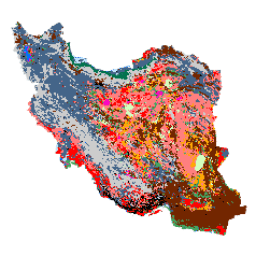
- Dostępność zbioru danych
- 2017-01-01T00:00:00Z–2018-01-01T00:00:00Z
- Dostawca zbioru danych
- K. N. Toosi University of Technology LiDAR Lab
- Tagi
Opis
Ogólnokrajowa mapa pokrycia terenu w Iranie została wygenerowana przez przetworzenie zdjęć z satelity Sentinel na platformie Google Earth Engine Cloud. W tym celu przetworzono ponad 2500 zdjęć z satelity Sentinel-1 i ponad 11 000 zdjęć z satelity Sentinel-2, aby utworzyć jeden zbiór danych mozaikowych za rok 2017. Następnie na podstawie dużej liczby próbek referencyjnych dla 13 klas wytrenowano metodę klasyfikacji opartą na obiektach Random Forest, aby wygenerować mapę pokrycia terenu w Iranie.
Pasma
Pasma
| Nazwa | Rozmiar piksela | Opis |
|---|---|---|
classification |
10 metrów | Klasyfikacja |
Tabela klasyfikacji
| Wartość | Kolor | Opis |
|---|---|---|
| 1 | #000000 | Region miejski |
| 2 | #006eff | Woda |
| 3 | #41a661 | Bagna |
| 4 | #ff7f7f | Kalut (yardang) |
| 5 | #bee8ff | Marshland |
| 6 | #ff00c5 | Salty Land |
| 7 | #ff0000 | Clay |
| 8 | #00734c | Las |
| 9 | #732600 | Outcrop |
| 10 | #ffaa00 | Niepokryta równina |
| 11 | #d3ffbe | Piasek |
| 12 | #446589 | Grunty rolne |
| 13 | #cccccc | Range Land |
Warunki korzystania z usługi
Warunki korzystania z usługi
Praca „Iran Land Cover Map v1 13-class (2017)” autorstwa Arsalana Ghorbaniana, Mohammada Kakooei, Meisama Amaniego, Sahela Mahdaviego, Alego Mohammadzadeha i Mahdiego Hasanlou jest objęta licencją Creative Commons Attribution 4.0 International (CC BY 4.0)
Cytaty
Ghorbanian, A., Kakooei, M., Amani, M., Mahdavi, S., Mohammadzadeh, A., & Hasanlou, M. (2020). Ulepszona mapa pokrycia terenu Iranu z wykorzystaniem zdjęć z satelity Sentinel w Google Earth Engine oraz nowego automatycznego przepływu pracy do klasyfikacji pokrycia terenu z użyciem przeniesionych próbek treningowych. ISPRS Journal of Photogrammetry and Remote Sensing, 167, 276-288. doi:10.1016/j.isprsjprs.2020.07.013
Odkrywanie za pomocą Earth Engine
Edytor kodu (JavaScript)
var dataset = ee.Image('KNTU/LiDARLab/IranLandCover/V1'); var visualization = { bands: ['classification'] }; Map.setCenter(54.0, 33.0, 5); Map.addLayer(dataset, visualization, 'Classification');
